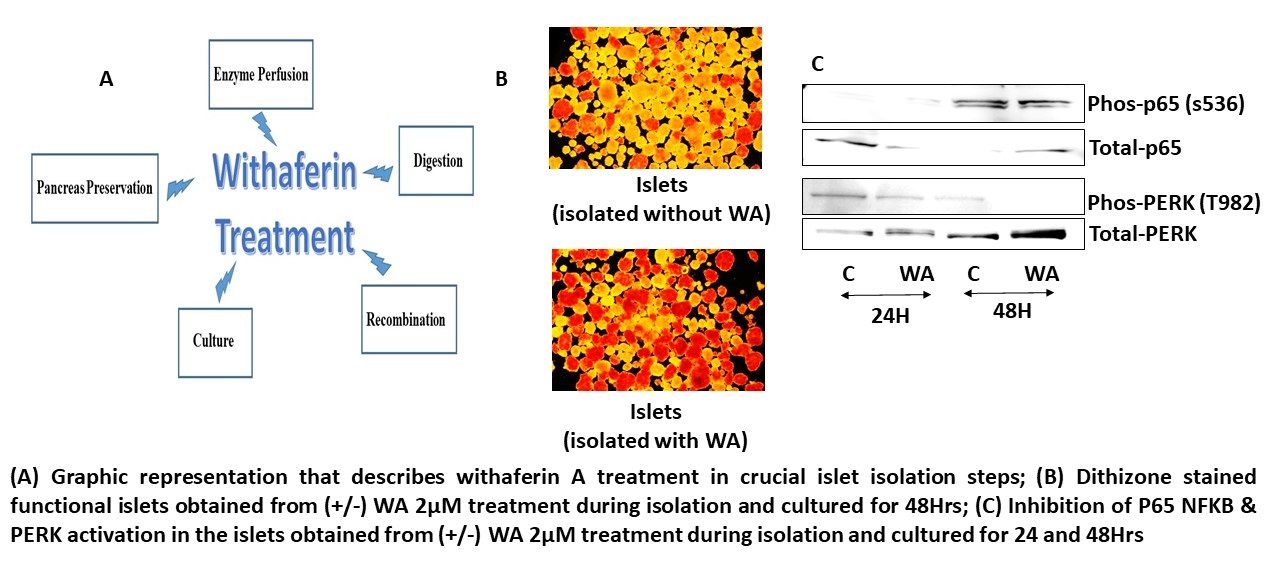
Withaferin A Prevents Inflammatory Phenotype in Cultured Islets
Prathab Balaji Saravanan1, Jagan Kalivarathan1, Bashoo Naziruddin2, Marlon F. Levy1, Mazhar A. Kanak1.
1Hume-Lee Islet Transplant Lab; Department of Surgery, VCU Health, Richmond, VA, United States; 2Baylor Simmons Transplant Institute, Baylor Scott and White Health, Dallas, TX, United States
Introduction: Islets undergo enormous ischemic, and mechanical stress throughout clinical isolation steps which affect the quality of processed islets available for transplantation. Isolated islets produce pro-inflammatory cytokines and chemokines that are further exacerbated during culture. Transplantation of islets with a strong pro-inflammatory phenotype may induce the activation of IBMIR and affect overall transplant outcomes. Strategies to improve the outcome of isolation and protection of islets from pro-inflammatory gene activation is an unmet requirement. Here, we sought to investigate the protective/anti-inflammatory effect of Withaferin A: a plant-derived inhibitor of Nuclear Factor Kappa B (NFκB).
Methods: A bisected split lobe isolation technique was adopted where the head and tail were isolated subsequently with a control or WA-treated (2µM) medium during isolation. WA was added in the isolation solutions including preservation media, Collagenase, Recombination Media, Wash Buffer, and also in islet culture media. The islets isolated from (+/-) WA treatment during isolation was analyzed for the viability, function, and intracellular pro-inflammatory cytokine expression. Western blots were performed to study the activation of transcription factors and stress-regulated genes post-culture. Exosomes were isolated and the presence of pro-inflammatory mediators was examined.
Results: Islet damage was reduced in the WA-treated group as shown by miRNA 375 release. No significant difference in the isolation outcomes such as yield, purity, and viability of islets between WA and the control group was seen. The purity of islets post-culture was better maintained in the WA treated group, compared to the control group (Figure 1). No difference in viability and insulin secretion was observed post-culture in the two groups. The western blotting of WA-cultured islets (at 24 and 48H) showed a significant reduction in the activation of p65 NFκB (P-s536) and P-IκBα (P-s32). Interestingly, WA treatment also synergistically reduced the activation of PERK (P-T982) and IRE1 mediated ER stress signals compared to the non-WA treated cultured islets. There was a significant reduction in the intracellular mRNA expression (Tissue factor, MCP1, and IL-8) and subsequent exosomal content of pro-inflammatory mediators (IP-10, IL-6, and IL-2) in the WA treated cultured islets (24 and 48H) compared to non-WA treated islets.
Conclusion: Withaferin A treatment prevented islet damage during isolation and also prevented the generation of a proinflammatory phenotype in islets post-culture. The study proposes a novel protective strategy to control islet inflammation during isolation and peritransplant steps which may improve the functional outcomes of transplantation.
